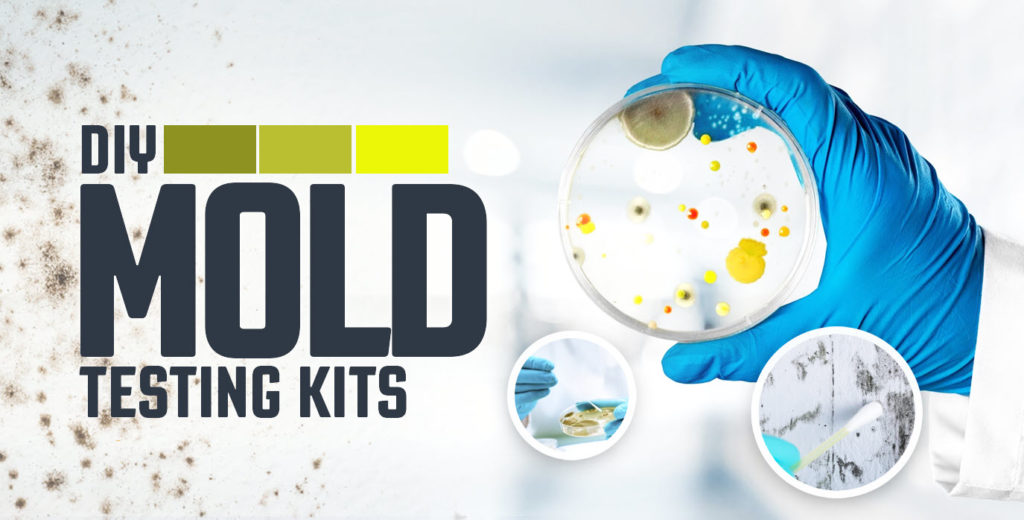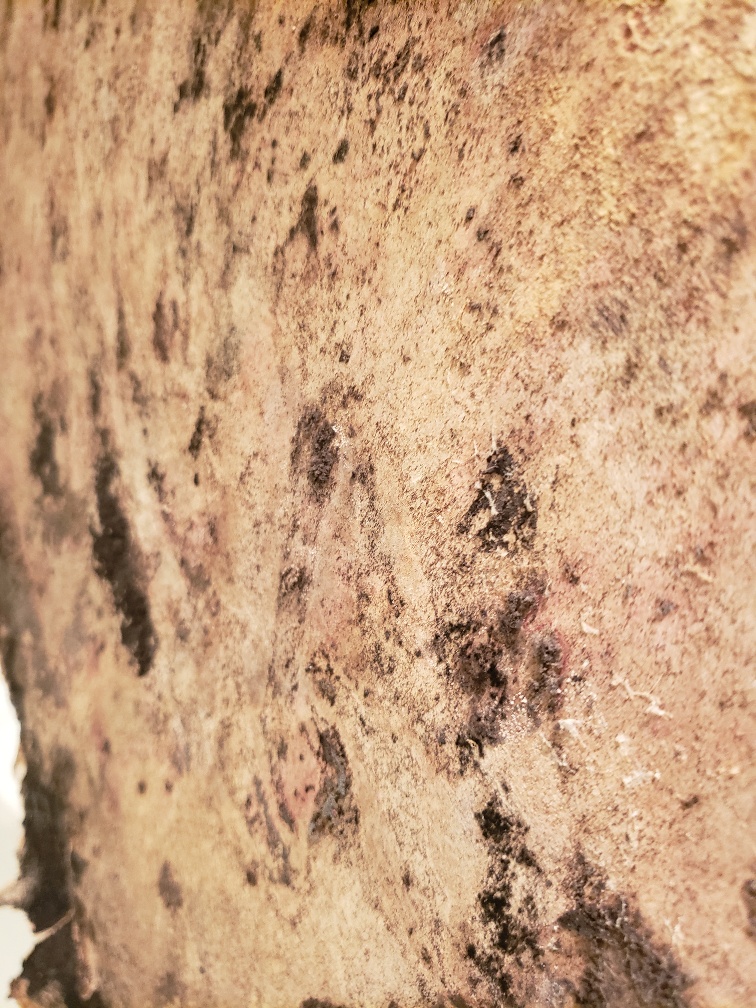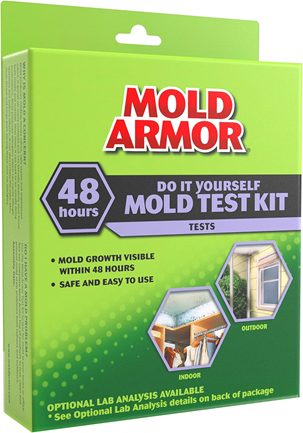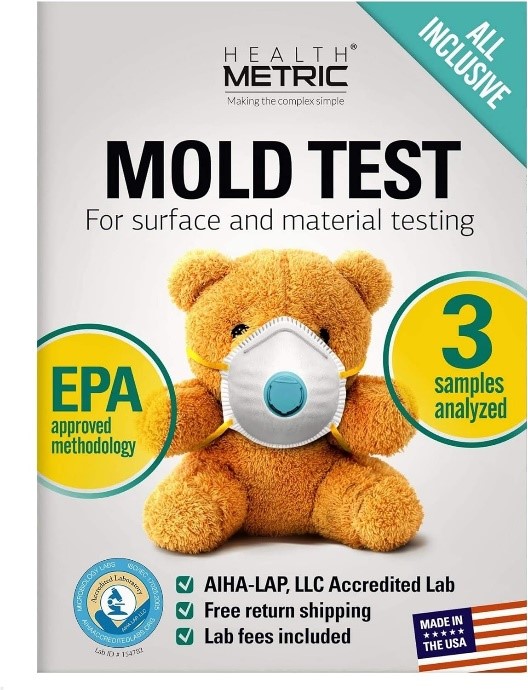Do you suspect mold presence in your home? Unfortunately, mold is not always visible. Yet preventing and avoiding it is important because it can have a serious impact on your health and the structural integrity of your home.
If you suspect a mold problem due to a musty smell, signs of water damage, or unexplained health symptoms DIY mold test kits are a good first step. These affordable kits allow you to test for mold on surfaces or in the air.

However, before rushing out to buy a kit, it’s crucial to understand their limitations. DIY tests can indicate whether mold is present, but they often cannot identify the specific type of mold or the severity of the problem. For those answers and safe mold removal, a professional assessment is usually necessary.
Homeowners who are concerned about potential mold problems in their home have a number of options as to how they can respond. One of the most popular things to do today when you have a problem is to immediately go online, learn what you can, and see if there is a product you can easily buy from your favorite online commerce site to help. This pattern holds true with mold problems just as well as with anything else. The demand for DIY home mold test kits has been soaring, and interest in the subject continues to increase.
How Mold Forms in Your Home
Mold takes hold in your home from mold spores, microscopic and invisible “mold seeds” constantly floating through the air. Mold grows when these spores settle on surfaces in your home.
Mold is not picky, but it does need the right environment to thrive:
- Stagnant air: Undisturbed spaces with limited airflow allow mold spores to settle and grow.
- The right temperature: Mold thrives at room temperature, 70 to 80 degrees Fahrenheit.
- Sustenance: Mold feeds on most materials that form surfaces in your home, wood, drywall, carpeting, and other plant-based materials.
- Moisture is key: The most important ingredient in the mold growth process is water.
Mold is not just an eye-sore, it can trigger health issues such as:
- Allergies and asthma flare-ups
- Persistent respiratory problems
- Skin irritation
- In severe cases, infections (especially in those with compromised immune systems)
If you notice a musty smell, see signs of water damage, or experience unexplained health symptoms, a DIY mold test kit (especially an air mold test kit) can be a valuable first line of defense. These affordable tests can alert you to mold’s presence, prompting further action.
The Problems with Mold

There are several problems that mold can present for those living in a home or working in an office that is infested with mold growth. Some of the less concerning include foul odors and aesthetic damage to surfaces, walls, and so on. Most of the problems, however, are far more severe.
First, though tiny, mold growing on surfaces is actually feeding on the underlying substrate material. Like any organism, they need food and nutrients to grow, and they get it from the building materials they colonize – pretty much anything that is cellulose (plant material) or cellulose-based, as well as some synthetics. Over time, this can damage the materials, and even compromise their structural integrity.
Far more pressing, however, are the health effects of mold. There are a wide range of different mold species, and while some are relatively innocuous, others can cause significant health effects. Allergic reactions, increased breathing or sinus problems, hives or skin reactions, and similar are most common. Some types of molds give off what are known as mycotoxins – toxic byproducts of their feeding process. These can cause still further health effects, and have been implicated in a number of deaths (most often from respiratory symptoms) over the years.
The health consequences of mold are one of the primary reasons why any mold growth in a home should be detected, identified, and remediated appropriately as soon as possible.
When to Use A DIY Mold Test Kit
DIY mold testing kits (like those found at your local Home Depot) offer a convenient and affordable way to get an initial read on potential mold problems in your home. They are a good option if you suspect an issue, but aren’t sure if it’s worth calling in a professional just yet.
Consider a DIY mold test kit in the following situations:
- Funky smell: A persistent musty odor, even without visible mold, could mean it’s hiding out of sight. A mold test kit can help confirm your suspicions.
- Discolored spots: If you notice spots or discoloration on walls, ceilings, or other surfaces, a mold test kit can verify whether it’s actually mold growth.
- After water-related problems and accidents: Recent leaks, flooding, or even smaller water mishaps can leave lingering moisture – the perfect breeding ground for mold. Testing can offer peace of mind, or prompt quick mold remediation.
- Health concerns: Are unexplained allergies, coughs, or respiratory issues plaguing you or your family? Mold could be the culprit, and a mold test kit can help confirm.
Remember, while a DIY mold test kit might confirm mold presence, only a professional mold removal service can accurately determine the type of mold and the extent of the spread of the mold.
DIY Mold Test Kit Buying Guide
If you are new to this, buying the right DIY mold test kit can feel like navigating a science fair project. Before you head to the store, you need to understand the different test options and define your specific needs. For example, are you trying to track down a hidden mold source or confirm if those suspicious discolored spots on the ceiling are mold?
Here’s what you need to know before buying a DIY mold-testing kit:
Understanding the Types of Tests
- Air sampling: These kits measure the concentration of mold spores in the air. This is great for catching mold that might be spreading from a hidden source.
- Surface sampling: Used to test visible areas of suspected mold. They come in forms like swabs or tape lifts, which directly collect a sample for analysis.
Accuracy: The Reality Check
DIY kits are a good starting point, but don’t expect the same level of detail as a professional lab analysis. They can indicate the presence of mold, but might not be able to pinpoint the exact species or the extent of the contamination.
Ease of Use: No Lab Coat Required
Most DIY kits pride themselves on simplicity. Look for clear instructions and easy-to-use collection tools. Some even offer online or app-based assistance to guide you through the process
The Cost Factor: Budget-Conscious Testing
Price tags on DIY mold test kits vary. Consider how many tests you need, whether lab analysis fees are included, and if some brands offer additional support
You should also check online reviews and compare features to make the right choice based on your budget and your specific needs.
Top 3 DIY Mold Test Kits
When a musty odor or suspicious stain sends up red flags, DIY mold test kits offer a first line of defense. But with so many options, which one is right for you? We’ve analyzed three popular kits, taking into account accuracy, ease of use, and value, to help you make an informed decision.

DIY Mold Test Buying Guide
Many homeowners may not want to jump right to a professional inspection at the first sign of mold. While professional inspections provide the most detailed information and advice, and are generally not that expensive, they are still more costly than off-the-shelf DIY mold tests (as is the case with any service call). Therefore, many consumers may choose to buy a DIY home mold test kit first to identify what kind of mold is present, or determine if it even is mold.
Depending on the type of kit purchased, and the details associated with it, it can take as little as 48 hours, or as long as several weeks to get the results. Therefore, depending on the suspected extent of your problem, it might be worthwhile to skip this stage and move immediately to a professional mold inspection in some cases. If you do choose to go the DIY home mold test kit route, then there are a few factors you’ll want to consider in picking a brand and type of test kit.
- Reviews and Rating Score
- How have other customers rated the product? What is the product’s reputation and the level of success that customers have had using the product?
- Brand Reputation
- Is the product from an established, reputable brand? What can you find out online about the brand and its reputation?
- Test Types
- There are several different types of mold test kits out there. Some are designed for indoor air quality, outdoor air quality, or other air-based testing. For the purposes of most home mold problems, you’ll want to find kits that allow material and surface testing, rather than air testing. Other test types can include HVAC-oriented kits (for vents) or more specific types of tests for certain material types.
- True DIY vs. Lab Testing
- One of the biggest decisions you’ll have to make surrounding DIY home mold test kits is whether or not you want a kit that you can use entirely on your own, or one which requires you to send off samples for lab testing. The former is obviously faster, though provides far less meaningful information. The latter can take longer, due to transit and testing times, but also provides much more useful information to guide remediation or cleanup efforts. It also typically comes with a significantly higher cost. Some kits include this in their price, whereas others offer it as a separate, add-on service not reflected in the purchase price of the kit.
- Quantity of Tests
- Of course, the number of tests inside a test kit will have a big impact on the price and usability of the test. Some only include a single test swab system, whereas others have multiple types of tests, or multiple units of each test included.
- Your Goals
- One of the biggest factors to consider is your goals for the test. Are you trying to determine what kind of mold might be present, or just confirm the presence of mold? Do you need results right away, or are you comfortable waiting for a few weeks for lab results? The purpose for your testing, and what you hope to achieve with the test results, should guide your decisions as to the type of test, quantity, and other factors to consider, and thus what test kit to buy.
- Price
- Like any purchase, the price is going to come into play in your purchasing decision as well. DIY home mold test kits can be as cheap as a few dollars, or as expensive as $100 or more. It all depends on what they offer, whether or not lab testing is involved, and the other factors discussed above. Just remember, as they get more expensive, you’re getting that much closer to spending as much as a professional mold inspection would likely cost. If you are fairly sure you have mold, and are considering spending this much on a test kit, it might be more economically viable (and potentially much faster) to get a professional mold inspection and skip the DIY mold test kit stage of things.
With all of those factors in mind, we’ve put together a list of the top 3 DIY home mold test kits currently available on Amazon today. Below, we highlight these three tests, each of which we’ve crowned as a winner within a certain category of products (e.g. most affordable).
You can click on any of the product names to get taken to the Amazon page for that product, and find out more about it. However, we’ve also provided our review, highlighting where it excels, where it may be deficient, and our thoughts on the product. Hopefully, this will serve as a good jumping-off point for you to choose your own path when it comes to DIY home mold test kits.
#1 – Mold Armor FG500 DIY Mold Test Kit

Lowest Priced/Most Affordable
- Rating: 3.6/5 Stars on Amazon
- Ideal For: Confirming Mold is Present Quickly and Cheaply
- Test Types: 3 (Air, HVAC, Surface)
- Test Units: 1
- Lab Testing: Optional
- Lab AIHA Certified: No
- Testing Cost: Additional $40
- Shipping Cost: Not Included
- Lab Results: Within 3 Weeks, 10-14 Days for Most Customers
- Contents: 1 Petri Dish, 1 Sterile Swab, 1 Bottle of Mold Growth Medium (Potato Dextrose)
The Mold Armor FG500 DIY Mold Test Kit is a barebones, entry-level offering, with the lowest price of the 3 kits on our list. This kit offers a single test, though is suitable for three types of tests – airborne, HVAC, and surface mold. It can be used to detect the presence of mold in these three situations, without the need for lab testing.
Essentially, it is a petri dish, swab, and growth medium. Instructions for use are included in the package. In 48 to 96 hours, if mold colonies are growing on the dish after you’ve swabbed per the instructions, then you have mold present and should consider the next steps. For $40 more, you can get a lab analysis of the mold, which takes about 10-14 days in most cases.
While this kit is useful for detecting the presence of mold and very affordable for that purpose, that’s about it. You need to pay for additional lab testing in order to learn more, and frankly, there are other kits that are better suited for that purpose.
You can also contaminate the petri dish fairly easily and may end up growing more than just mold from a surface in the home. Effectively, this is the most error-prone and least informative but can serve a useful purpose as a “yes/no” test for the presence of mold when used properly. The limitations of the kit are reflected in its substantially lower pricing than other kits.
#2 – Mold Inspection Network DT-28356 DIY Mold Inspection Kit

Mid-Range Test Kit
- Rating: 4.5/5 Stars on Amazon
- Ideal For: Affordable Lab Testing of Surface Mold Samples
- Test Types: 1 (Surface)
- Test Units: 3
- Lab Testing: Required, Free Consultation with Results
- Lab AIHA Certified: No
- Testing Cost: Included in Price Except in Texas (Add $24 Fee)
- Shipping Cost: Not Included
- Lab Results: Time Not Stated, Most Customers Within 14 Days
- Contents: 3 Tape-Lift Surface Testing Units, Instructions, Mold Inspection Booklet
This test kit is a good middle-of-the-road choice. It’s only focused on surface mold testing (rather than airborne mold testing), which is really the main practical concern for most people so this is not really a limitation. The kit includes 3 test units, that use a tape-lifting method of sampling (as opposed to swabbing). This is a fairly common approach and can be reliable in providing sufficient sampling for laboratory identification of surface molds.
The lab testing is included in the price of this kit for all 3 units, except in the state of Texas (for a regulatory reason). Residents of Texas must add $24 to the cost to obtain testing. Lab results include a written report and free consultation with an expert over the phone. The product tests for all types of mold, whereas many others may only look for a few key types or genuses of mold. Effectively, this is a good option if you’re not ready for a professional inspection, but want to know more than simply whether or not that black or green stuff on the wall is mold.
#3 – Health Metric All-Inclusive DIY Mold Test Kit for Home

Most Detailed, All-Inclusive Kit
- Rating: 4.3/5 Stars on Amazon
- Ideal For: All-Inclusive (No Extra Fee) Lab Testing of Surface Mold Samples
- Test Types: 2 (Surface and Bulk Material)
- Test Units: 3-6 (3 Pre-Paid for Lab Testing)
- Lab Testing: Required
- Lab AIHA Certified: Yes
- Testing Cost: Included in Price
- Shipping Cost: Included in Price
- Lab Results: 5-7 Business Days After Receipt, 10-14 Days Total for Most Customers
- Contents: 6 Plastic Collection Trays, 4 Plastic Bags, 1 Tape Pad, Instructions, Testing Guide, Shipping Instructions, Pre-Paid Shipping Label and Return Mailer
The most detailed, all-inclusive kit currently available, the Health Metric DIY Mold Test Kit for Home allows for both surface testing via a tape-lift method, as well as bulk material sampling (which can look at more than just the surface). It is also the only test we’ve featured here that uses an AIHA-accredited lab, the highest standard for mold testing, which provides a higher degree of certainty in the results. There are no added or hidden fees, either – everything is included in the purchase price, including shipping and lab testing.
You can choose to take surface samples or include bulk samples of material (such as a small piece of drywall) for testing, which provides far more range than other tape-lift-only or swab-based test kits. Lab results include a helpful report that lists the types of mold and the severity from the sample – none detected, minor, moderate, or heavy. Technically, you can even take 6 samples with this kit given all the materials included – 3 surface and 3 bulk – though lab testing costs are only included for 3 tests. Still, in terms of overall cost, quality, and what’s included, the Health Metric test is definitely worth the price.
Steps You Can Take to Reduce or Prevent Mold
By taking the necessary precautions and a few simple changes, you can prevent mold and the need to buy a DIY mold test kit.
- Humidity Matters: Aim to keep humidity levels between 30-40%. Dehumidifiers (portable or built into your HVAC system) help and humidity monitors let you track trouble spots around the house.
- Don’t Let Water Linger: Fix leaks and appliance malfunctions quickly. Mop up spills and bathroom splashes to stop moisture from seeping into hidden places.
- Get Some Air Flow: Fresh air and good ventilation balance humidity and make it harder for mold spores to settle. Use fans or open windows, especially in damp areas like basements or attics.
- Keep a Vigilant Eye: Regularly inspect walls, floors, ceilings, and furnishings for signs of discoloration (that might mean mold!). Early action prevents it from spreading.
- When Disaster Strikes: Major water damage from storms or plumbing issues? Professional drying and cleanup are essential to stop mold in its tracks.
- Healthy HVAC, Healthy Home: Regular maintenance on your heating and air conditioning system promotes good circulation and helps filter out mold spores.
- Cleaning Counts: Regular cleaning of surfaces helps remove microscopic mold before it becomes a visible problem.
Bottom Line
Mold might be a formidable foe, but you’re now better equipped to fight back! DIY mold test kits offer a starting point for investigation, providing clues about potential problems lurking in your home. By understanding the dangers of mold, using these kits wisely, and taking proactive prevention steps, you can create a healthier living space for yourself and your family.

